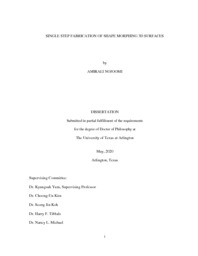
ATTENTION: The works hosted here are being migrated to a new repository that will consolidate resources, improve discoverability, and better show UTA's research impact on the global community. We will update authors as the migration progresses. Please see MavMatrix for more information.
Show simple item record
| dc.contributor.advisor | Yum, Kyungsuk | |
| dc.creator | Nojoomi, Amirali | |
| dc.date.accessioned | 2022-07-14T15:57:06Z | |
| dc.date.available | 2022-07-14T15:57:06Z | |
| dc.date.created | 2020-05 | |
| dc.date.issued | 2020-06-04 | |
| dc.date.submitted | May 2020 | |
| dc.identifier.uri | http://hdl.handle.net/10106/30689 | |
| dc.description.abstract | Shape-changing materials that can adopt programmable 3-dimensional (3D) shapes offer promise for a wide range of applications. Form the formation of the leaves and flowers to the shaping of complex organs, the analogues of such shape-morphing 3D surfaces are abundant in nature. However, since the formation of such surfaces in biological systems is fundamentally different from that of human-made materials, replicating their complex morphologies, movements, and thereby functions remains a challenge. Inspired by living organisms, we introduce an approach, called digital light 4D printing (DL4P), that encodes thermosensitive 2D hydrogels with a specific pattern of network density and thus temperature-induced growth (expansion and contraction) to create 3D structures with programmed shapes and motions. 3D self-shaping happens readily upon the introduction of the programmed 2D hydrogels into water medium, where programmed non-uniform in-plane growth defines a new metric tensor (target metric) for the surface, which causes a controlled out-of-plane buckling and results in a specific three-dimensional shape. A theoretical platform was introduced for axisymmetric 3D shapes, predicting how a target metric translates to a 3D shape and vice versa. We next introduced modular-based design rules for making complex 3D structures and addressed control of the direction of deformation in non 2 Euclidean systems. By controlling the spatial rates of shape transformations, we created 3D structures with complex programmed sequential motions similar to living organisms. To broaden the application of our method beyond soft-materials, we established a thermal/chemical shape stabilization process to achieve robust air-stable 3D surfaces in the ambient environment. Unlike traditional layer-by-layer additive manufacturing, our controlled out-of-plane deformation mechanism allows the creation of 3D structures in a short amount of time from a single layer material. The digital patterning used in this method offers simultaneous printing of 2D materials encoded with custom-designed metrics, rendering it scalable for creating diverse 3D shapes. | |
| dc.format.mimetype | application/pdf | |
| dc.language.iso | en_US | |
| dc.subject | 4D Printing | |
| dc.subject | Shape-morphing | |
| dc.title | SINGLE STEP FABRICATION OF SHAPE MORPHING 3D SURFACES | |
| dc.type | Thesis | |
| dc.date.updated | 2022-07-14T15:57:06Z | |
| thesis.degree.department | Materials Science and Engineering | |
| thesis.degree.grantor | The University of Texas at Arlington | |
| thesis.degree.level | Doctoral | |
| thesis.degree.name | Doctor of Philosophy in Materials Science and Engineering | |
| dc.type.material | text | |
| dc.creator.orcid | 0000-0002-2868-6126 | |
Files in this item
- Name:
- NOJOOMI-DISSERTATION-2020.pdf
- Size:
- 3.852Mb
- Format:
- PDF
This item appears in the following Collection(s)
Show simple item record


